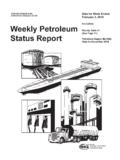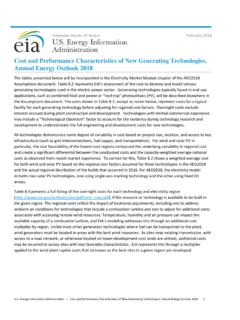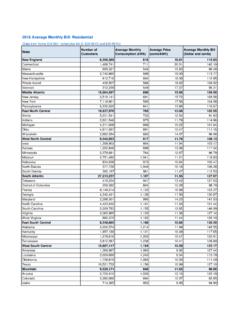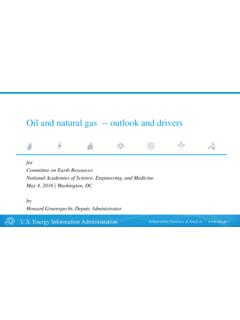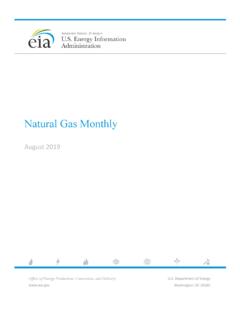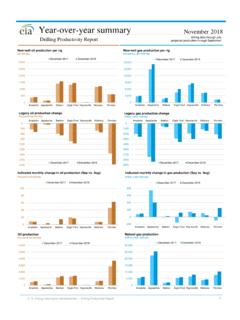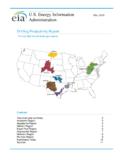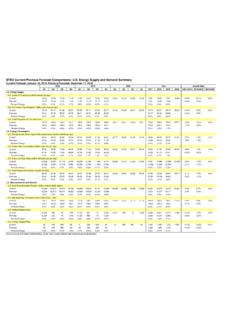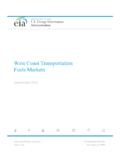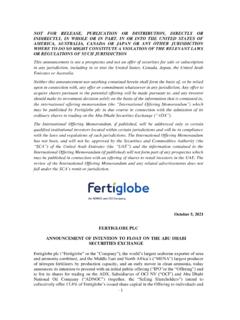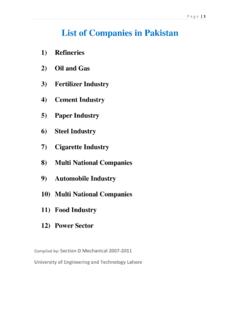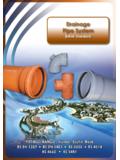Transcription of Country Analysis Executive Summary: United Arab Emirates
1 1 Country Analysis Executive Summary: United Arab Emirates Last Updated: May 6, 2020 Overview As of 2019, the United Arab Emirates (UAE) is among the world s 10 largest oil producers and is a member of the Organization of the Petroleum Exporting Countries (OPEC) and the Gas Exporting Countries Forum (GECF). A member of OPEC, the UAE is currently the seventh-largest petroleum and other liquids producer in the world. Based on a seven-month total of revenues collected through July 2019, hydrocarbon export revenues are projected to account for $72 billion in 2019, about 25% of all export The UAE has abundant natural resources. Relatively energy intensive compared with other industrialized countries, the UAE s economy is fueled largely by natural gas and petroleum and other liquids (Figure 1). petroleum and other liquids40%natural gas59%hydroelectricity1%Source: BPStatistical Review of Energy, 2019 Figure 1.
2 Total primary energy consumption in the UAEby fuel type, 20182 In addition to the Country s large hydrocarbon economy, the UAE is becoming one of the world s most important financial centers and a major trading center in the Middle East. Investments in non-energy sectors, such as infrastructure and technology, as part of the Vision 2021 agenda, continue to provide the UAE with long-term insurance against oil price declines and global economic Petroleum and other liquids The UAE is a major oil producer and exporter. In 2019, the Country produced an average of million barrels per day of petroleum and other liquids, the seventh-highest total in the world. Reserves According to Oil & Gas Journal estimates as of January 2020, the UAE holds the seventh-largest proved reserves of oil in the world at 98 billion barrels,3 with most of the reserves located in abu dhabi (about 96% of the UAE s total).
3 The other six Emirates account for just 4% of the UAE s crude oil reserves, led by Dubai with about 2 billion The UAE holds about 6% of the world s proved oil Production and Consumption The UAE produced million barrels per day (b/d) of petroleum and other liquids in 2019, of which about million b/d was crude oil and the remainder was non-crude oil liquids (condensate, natural gas plant liquids, and refinery processing gain) (Figure 2). The UAE was the third-largest petroleum producer in OPEC in 2019 behind Saudi Arabia and Iraq. 3 The UAE plans to increase crude oil production capacity from million b/d to million b/d in 2030,6 but with limited prospects for major discoveries, production increases in the UAE will come almost exclusively by using enhanced oil recovery (EOR) techniques in abu dhabi s existing oil fields. Recent exploration in the UAE has yielded several discoveries of crude oil, equaling 1 billion barrels of oil in The UAE emphasizes EOR techniques designed to extend the lifespan of the emirate s existing oil fields.
4 By improving the recovery rates at the existing fields, such techniques helped the UAE to nearly double the proved reserves in abu dhabi during the past decade. Exports The UAE is both a major exporter and consumer of petroleum liquids. According to ClipperData, the UAE exported more than million b/d of waterborne crude oil in 2019, and most of it went to Japan (29%) and other markets in Asia (Table 1).8 : Energy Information Administration, InternationalEnergy Statistics and Short-Term Energy OutlookproductionconsumptionFigure 2. UAE total petroleum and other liquids supply and consumptionmillion barrels per day4 Table 1. UAE crude oil exports by region, 2019 Region Share Asia 93% Other 4% Africa 2% Source: Energy Information Administration, based on ClipperData, Inc., data The UAE domestic market relies on imports to meet demand for some petroleum products.
5 Most of the UAE s petroleum imports are residual fuel oil, with limited imports of motor gasoline and diesel fuel. Already the world s second-largest bunkering port, the export terminal in Fujairah will expand its storage capabilities significantly over the coming years. Plans to expand the terminal include several new private tank storage units, which have an anticipated capacity of 42 million barrels by When complete in 2022, the abu dhabi state oil firm abu dhabi national Oil company s (ADNOC) Fujairah Underground Storage facility will be able to store three different types of crude oil, providing ADNOC with increased flexibility to export crude oil through Fujairah s Arabian Sea oil terminal. Refining The UAE has four refining facilities, the largest of which is the Ruwais facility (Table 2). Currently the Ruwais facility has a refining capacity of 817, 000 b/d.
6 ADNOC announced plans in May 2018 to develop Ruwais into the world's largest refining and petrochemicals complex to increase refining capacity by more than 65% to million b/d by 2025. The expansion includes a plan to build a mixed feed cracker to triple ADNOC's production capacity to million metric tons per year (MMmt/year) from MMmt/year in 2016. Table 2. UAE s refineries Refinery Capacity (thousand barrels per day) Ruwais 817 Jebel Ali 140 Umm Al-Narr 85 Fujairah 82 Source: Organization of the Petroleum Exporting Countries, Annual Statistical Bulletin, 2019 5 In addition, the UAE plans to invest in a new 250,000 b/d Fujairah refining complex focused on producing bunker fuel that complies with the International Maritime Organization s sulfur regulations. The first phase is expected to be operational by the first quarter A new 600,000 b/d refining and petrochemical complex in Ruwais is expected to be complete by The UAE and neighboring Oman plan to build a jointly operated refinery in the Duqum special economic zone that would have a capacity of 230,000 b/d by Natural Gas The UAE plans to boost domestic natural gas production over the next several years to help meet growing internal demand.
7 Much of the growth could come from the Country s large sour (high-sulfur) gas deposits. Reserves The UAE holds the seventh-largest proved reserves of natural gas in the world at 215 trillion cubic feet (Tcf).13 Production and Consumption According to preliminary EIA estimates, dry natural gas production in the UAE rose to Tcf in 2018, continuing the upward trend that began in the late 1970s (Figure 3). Despite the challenges of producing natural gas domestically, the UAE hopes to further boost production to help meet the Country s growing demand. 3. UAE dry natural gas production and consumptiontrillion cubic feetproductionconsumptionSource: Energy Information Administration, International Energy Statistics Note: Preliminary estimates for 2018 data 6 According to EIA preliminary estimates, natural gas consumption in the UAE reached a record high of more than billion cubic feet (Bcf) in 2018.
8 Solid economic growth and the resulting energy demand over the past few years are straining the Country s natural gas supplies. The UAE uses a large amount of natural gas in its extensive EOR operations and to operate its many power plants and desalinization plants. The UAE will likely need to continue importing large volumes of natural gas to meet domestic demand, at least in the near term. Imports The UAE became a net importer of natural gas in 2008 as UAE consumption exceeded production. Although the UAE continues to produce and increase domestic natural gas output, domestic demand growth has far outpaced production growth during this period. According to OPEC, natural gas imports grew from 391 Bcf in 2006 (the year before the Dolphin Energy pipeline came online) to 919 Bcf in 2018 (Figure 4). Most UAE natural gas imports come from Qatar through the Dolphin Energy pipeline project, a Bcf per day, 226-mile subsea pipeline, which also connects to the other Emirates and Flows through the Dolphin pipeline have remained relatively constant at about 2 Bcf/d because Qatar s compression facilities and contracted export volume limits the The pipeline supplies all seven Emirates and meets about 26% of the Country s natural gas demand.
9 In 2014, the UAE started importing liquefied natural gas (LNG) from Dubai s Floating Storage and Regasification Unit (FSRU). The UAE secured a second FSRU-based import terminal in abu dhabi and has been operational since September 2016. 02004006008001,0001,20020062007200820092 01020112012201320142015201620172018billi on cubic feetSource: Organization of the Petroleum Exporting Countries, Annual Statistical Bulletin, 2019importsexportsJuly 2007: Dolphin Energy Pipeline beginsshipping natural gasFigure 4. UAE s natural gas imports and exports 7 Exports In 2018, the UAE exported 250 Bcf of natural gas, mostly in the form of LNG, according to OPEC (Figure 4). Nearly all of the UAE s LNG exports were destined for Japan in 2018, and smaller amounts were exported to India, Taiwan, and Although the UAE plans to expand development of domestic natural gas reserves, low LNG spot prices have reduced economic incentives to bring costly, high-sulfur fields online.
10 Electricity The UAE is planning to add nuclear, renewable, and coal-fired electricity generating capacity to accommodate rising demand, but the Country currently relies primarily on natural gas. Rapid economic and demographic growth during the past decade pushed the UAE s electricity grid to its limits. Installed generation capacity continues to rise, reaching 30 gigawatts (GW) in The UAE generated 98% of its electricity in 2018 using natural gas-fired Electricity consumption in the UAE reached nearly 127,000 gigawatthours (GWh) in 2017, placing the UAE among the largest electricity consumers per capita in the In January 2017, the UAE launched its Energy Strategy UAE 2050 energy strategy would diversify the Country s energy mix and include 12% clean coal, 38% natural gas, 6% nuclear energy, and 44% clean energy (solar power, wind power, and biofuels).
